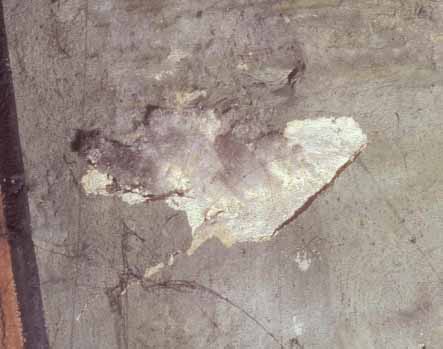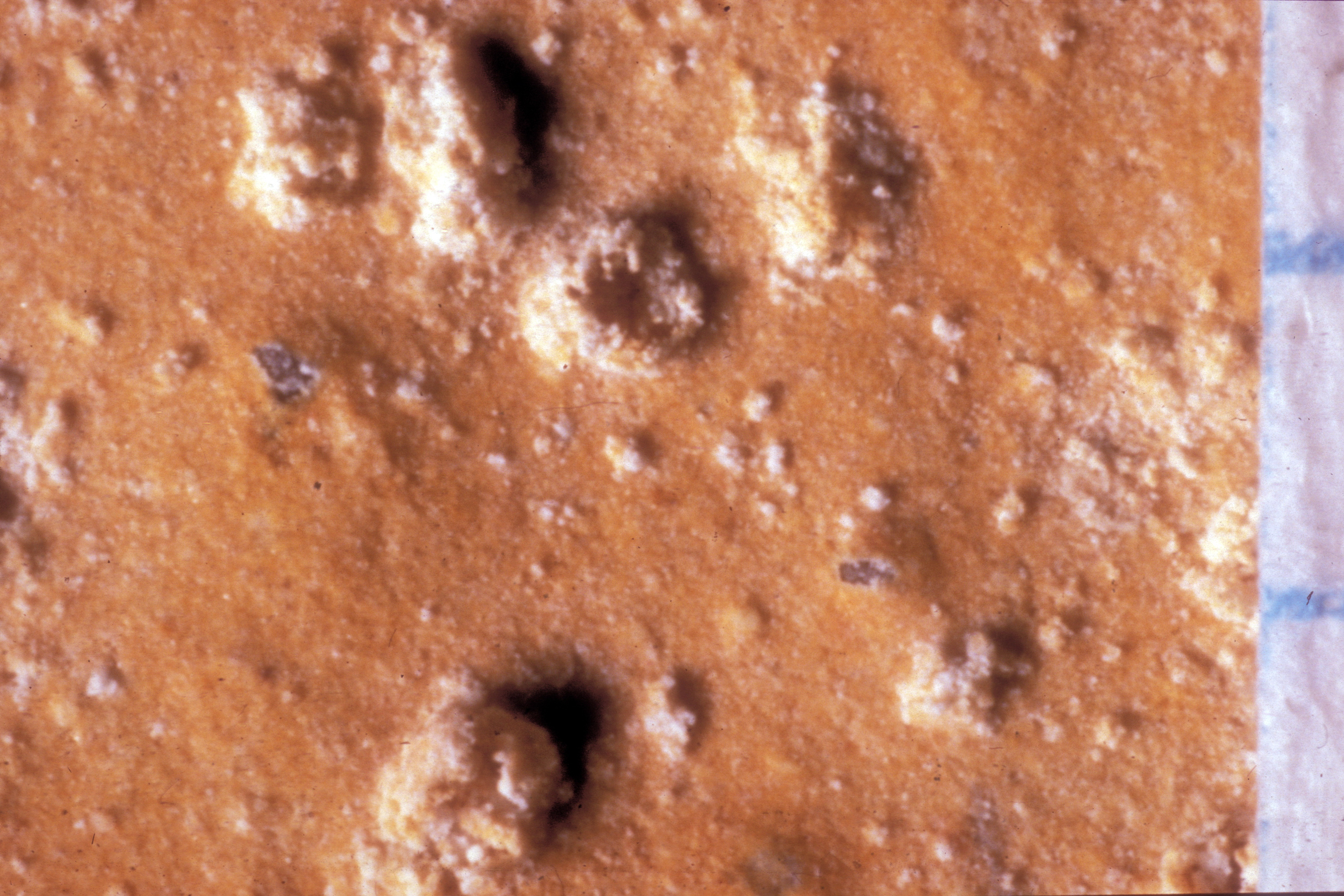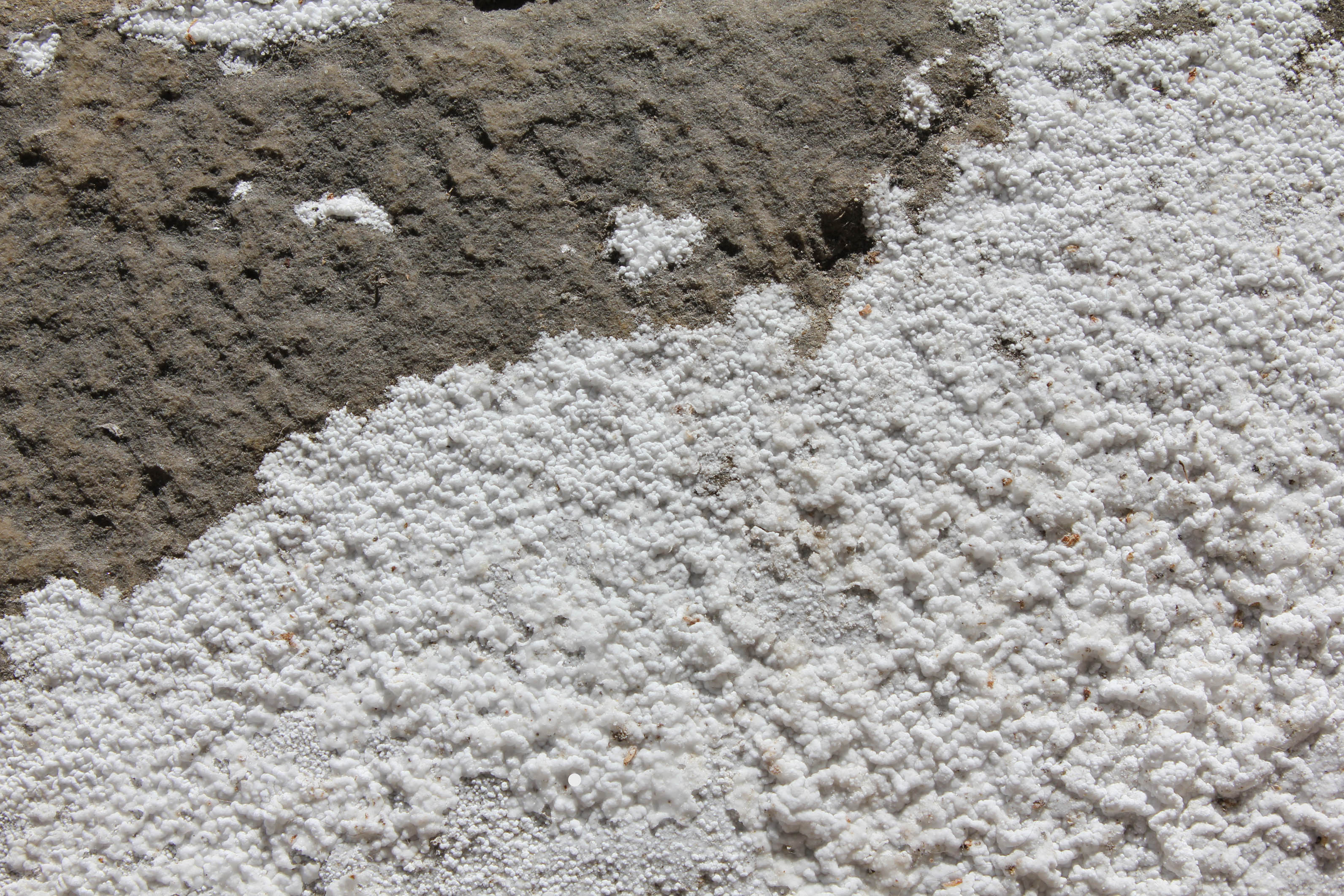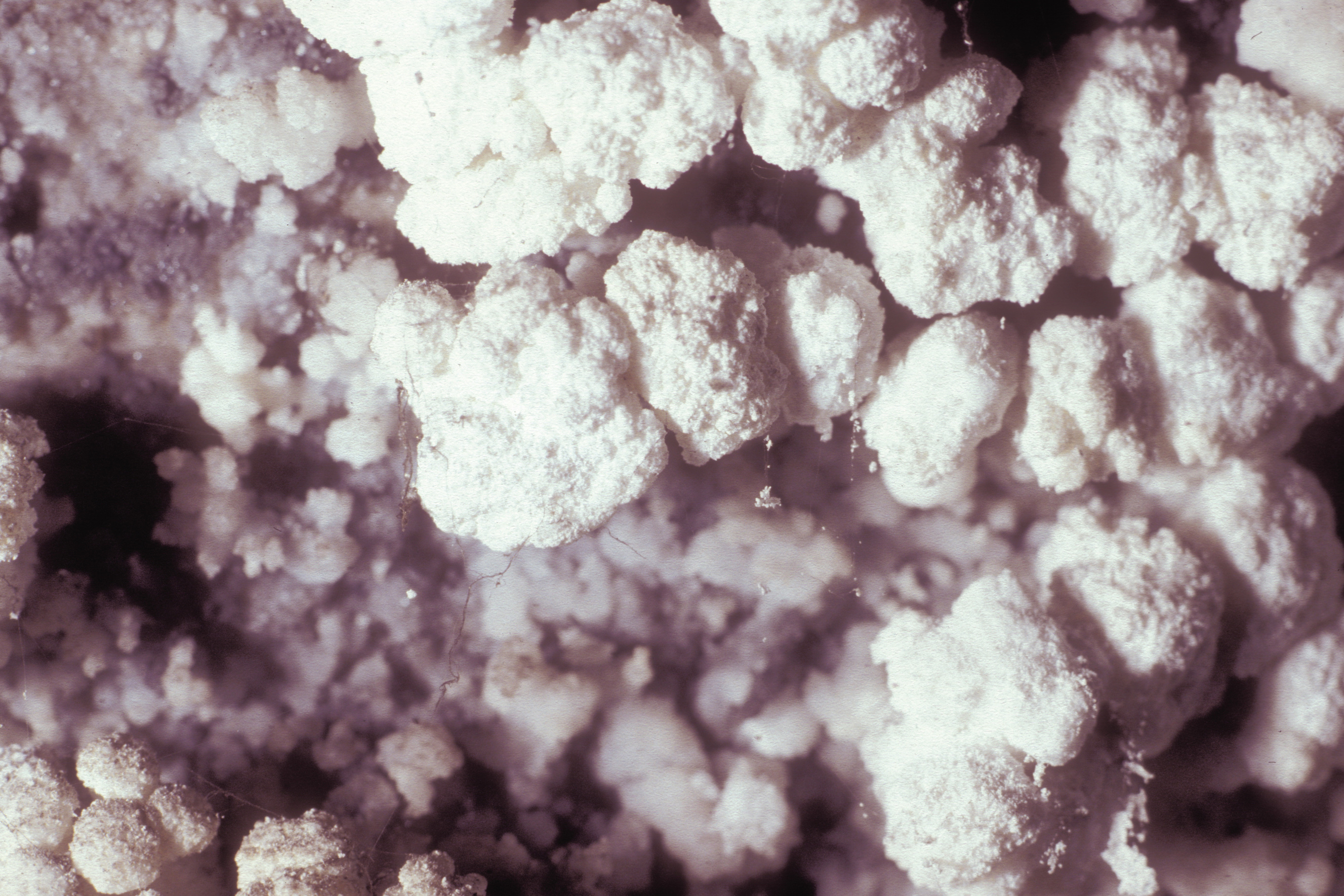Deterioration Patterns
<bibimport />
Author: Hans-Jürgen Schwarz
back to SaltWiki:Portal
Introduction[edit]
To assess new damage, well documented and analysed decay pattern are of great importance. This collection provides an overview of decay pattern, which have been observed in the different material groups.
Material based collections of decay pattern are available for:
Glossary of salt Efflorescences[edit]
In general efflorescences are whitish, powdery or whisker-like crystals on the surface, generally poorly cohesive and commonly made of soluble salt crystals.
On the objects, especially wall paintings, mortar, plaster, ceramic and natural stone, efflorescences repeatedly show certain typical forms, which will here be briefly characterized.
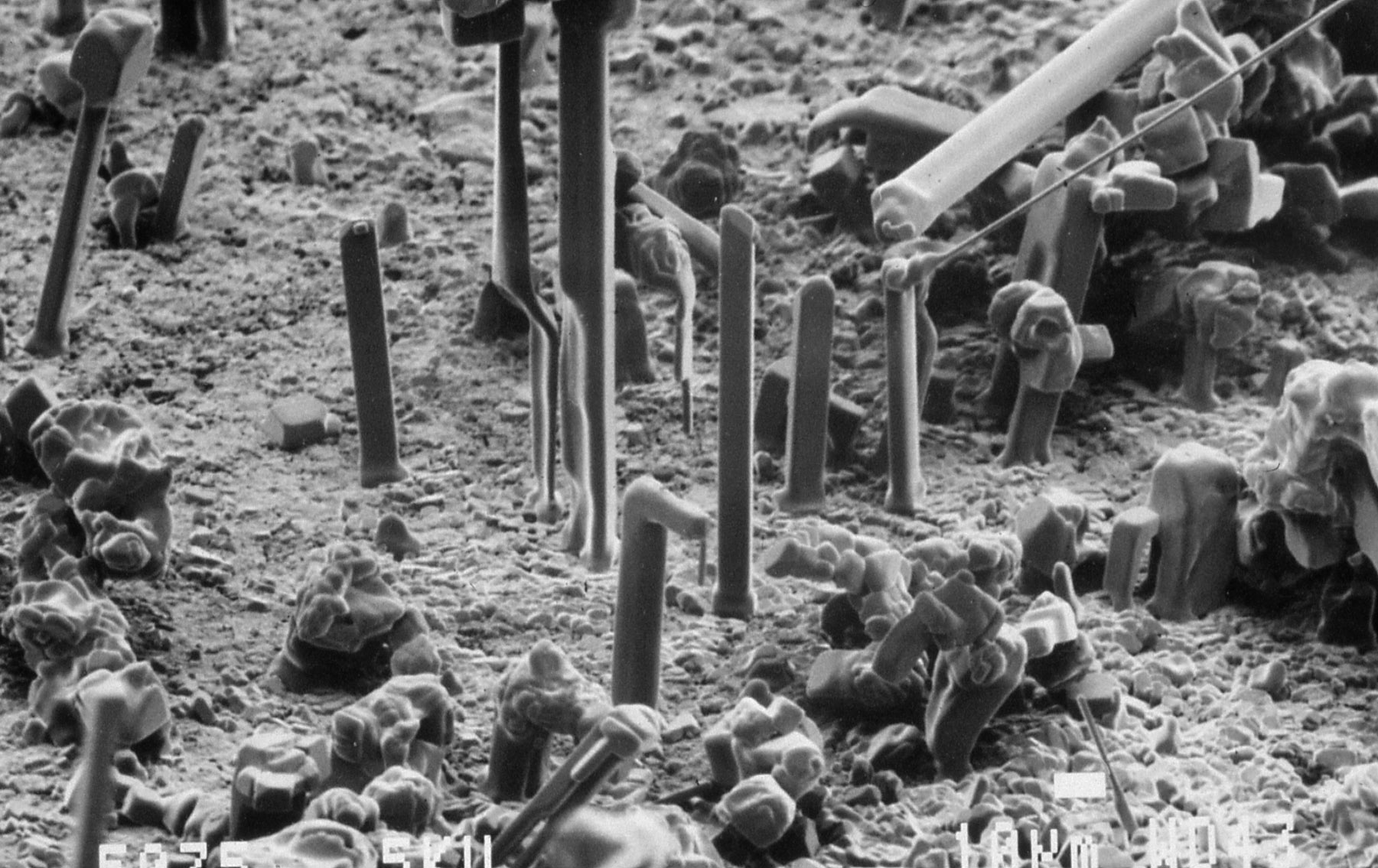
Author: Arnold, Andreas; Zehnder, Konrad
 )
)Whisker (=Haarkristalle): a few microns thick to cm - long, columnar, often curved crystals. Under special conditions crystals, in which a needle-like habit is usually not typical, growing in fine hair-like individuals, the so-called whiskers. Whiskers have been observed in a variety of substances, metals, salts and other compounds. Their diameters are between 0.01 and 100 micron, while their length can reach the order of centimeters. They grow preferentially in the longitudinal direction, while the cultivation of substance on the side faces is either totally suppressed or, to some extent still happen later. There are whiskers that include along their axis, a single (or few) screw dislocation, which causes a spiral growth at the tip, the material along the side of the tip must be transported. There are also whiskers without screw dislocations, which is the preferred growth at the top by a different mechanism about. Finally, there are whiskers do not grow at the top, but at its base, a pushing up the growing crystal.
Salzflaum: very loose, wool or cotton-like efflorescence, usually consisting of bent whiskers.
Salzrasen: loose, acicular to columnar whiskers, more or less perpendicular to the surface, 0.1 to several millimeters large, often only visible in raking light.
Pulverige Salzausblühungen: white, mealy, loose to dense or fluffy coat. Powdery efflorescences depend on the salt type. Some salts, especially the somewhat less soluble, such as gypsum, can bloom from the beginning in this very fine crystalline form. When sodium sulfate, this form is usually a sign that there is a dehydration product of the once water-containing salt.
Salzpusteln: separate, loose to compact, to about 1 mm diameter large salt crystals.
Salt crust : Crust composed of soluble salts, which develop in the presence of high salt levels, salt aggregates with planar cohesion and of very different thickness (a few microns to mm)
White loose crust (sugary crust): It consists of units that are visible to the naked eye or low magnification as glass-clear crystals. Sugary crusts usually form in a moisture film. However, they can crystallize from a salt efflorescence that takes up water from the surrounding air and goes into solution and crystallizes again in a dry climate.
Satin Crust: Flat, shiny crust of salt. Thick ....crusts of gypsum are formed only by repeated recrystallization and over longer periods.
Cauliflower crusts: Crust of white, spherical aggregates, so that its surface resembles that of a cauliflower. Cauliflower crusts occur preferentially at small defects (cracks or similar) on an otherwise relatively dense plaster surface.
Fiber crust: Crust made of whisters, close to each other, perpendicular to the substrate. They arise usually on moist substrates.
Tracht und Habitus[edit]
- Die Größenverhältnisse der an einem Kristall vorhandenen Grundformen ergeben den Habitus eines Kristalls.
- Die Tracht eines Kristalls besteht in der Aufzählung aller am jeweiligen Kristall auftretenden Grundformen.
Verschiedentlich wechselt der Habitus eines Minerals in Abhängigkeit von den Bildungsbedingungen.
Bedingt durch die Kristallstruktur, auch durch Mineral und Flächenkombinationen, haben die Minerale z.T. eine typische, z.T. wechselnde räumliche Erscheinungsform. Verschiedentlich kann diese auch durch einseitiges Wachstum hervorgerufen werden. Wir beschreiben diese Mineralformen wie folgt:
- isometrische Formen, wenn die Entwicklung in allen drei Raumrichtungen etwa gleich groß ist, z.B. bei allen kubischen Kristallen
- eindimensional gestreckte Formen: säulenförmig, stengelig, nadelig, haarförmig, faserig, z. B. Turmalin, Rutil, Asbest
- zweidimensional gestreckte Formen: tafelig, plattig, blättrig, schuppig, besonders bei Schichtmineralien, z.B. Baryt oder Glimmer
- dentrische Formen haben Minerale, wenn durch Wachstumsstörungen nur eine unvollständige, skelettartige Ausbildung möglich ist.
Formation of salt crystals, according to Arnold[edit]
The crystal morphology (habit)depends on the moisture conditions after [Arnold:1992]Title: Salze: Lästige weiße Ausblühungen oder Hauptschadensursache?
Author: Arnold, Andreas as follows (see figure):
as follows (see figure):
a) Allseitig wachsende, große Kristalle mit Gleichgewichtsformen bilden sich auf nasser Unterlage, wobei die wachsenden Kristalle tief in die Lösung eingetaucht bleiben, die als dicker Lösungsfilm die ganze Oberfläche oder Teile davon bedeckt
b) Eine körnige Kruste aus isometrischen Kristallen entsteht auf noch stark feuchtem Substrat, während die Kristalle mit dem Lösungsfilm überdeckt sind und allseitig wachsen
c) Eine Faserkruste bildet sich auf mittelfeuchtem Substrat, das von einem zusammenhängenden Lösungsfilm bedeckt wird. Die säuligen Kristalle wachsen an ihrem Fuß, wo sie noch im Kontakt mit der Nährlösung sind und werden emporgehoben.
d) Dicke Whisker-ähnliche Kristalle wachsen auf der leicht feuchten Oberfläche aus kleinen Lösungsinselchen
e) Sehr dünne Whisker aus "Lösungspünktchen" auf der nun fast trockenen Oberfläche. Daraus entsteht ein Salzflaum.
Salze bilden bei ungestörter Kristallisation aus der Lösung ihre charakteristische Kristallform aus. Man spricht dann von idiomorphen Kristallen. Hypidiomorphe Kristalle bilden nur teilweise ihre Eigengestalt aus, während bei einer xenomorphe Kristallisation, die Kristallform keinerlei Beziehung zur Eigengestalt hat.
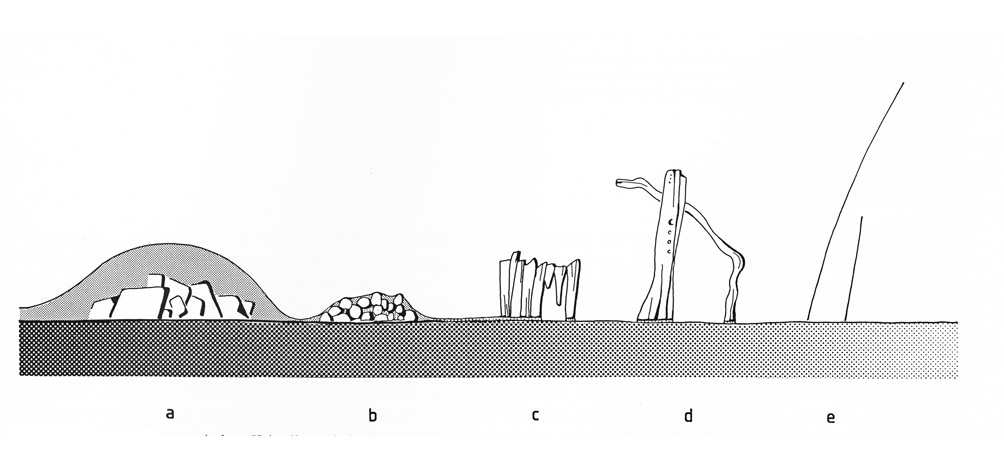
Author: Arnold, Andreas
 )
)Literature[edit]
[Filter missing]
